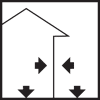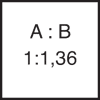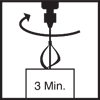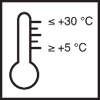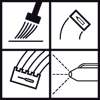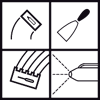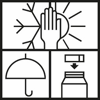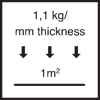Article No. 301408
Multi-functional building waterproofing Combines the properties of flexible and crack-bridging mineral waterproofing slurries (MDS) and bitumen thick coatings (PMBC)
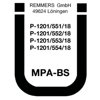
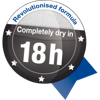
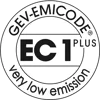
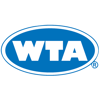
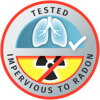
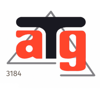
Downloads & documents
Product specifications
The stated values represent typical product characteristics and are not to be construed as binding product specifications.
Field of application
- Rapid waterproofing
- Waterproofing in new buildings
- Horizontal waterproofing in and underneath walls
- Subsequent waterproofing of existing buildings according to WTA
- Can be applied > 3 m in the ground
- Approved for connecting to water impermeable concrete structures
- Waterproofing of plinths and base points
- Waterproofing in a bond
- Bonding layer on old bitumen coatings
Properties
- Tested on crack formation of greater than 3 mm (according to DIN EN 14891)
- Complete drying and cross-linking occur rapidly, after just 18 hours at 5 °C and 90 % rel. humidity.
- Meets the test requirements for PMBC
- Radon-tight (verified through testing)
- Very low emissions (GEV-EMICODE EC 1Plus)
- Solvent-free
- Bitumen-free
- Water pressure tight
- High tensile adhesion strength
- Excellent adhesion even on non-mineral substrates (e.g. plastics, metals)
- Highly flexible, elastic and crack-bridging
- Can be covered after a very short time (≥ 4h)
- UV-resistant
- Freeze/thaw-resistant
- Can be plastered and painted over
- Can be applied as a slurry, with a brush or trowel, or by spraying
-
Preparation
-
Substrate requirements
The substrate must be clean, dry, flat and capable of bearing a load, and free of dust, oil, grease and release agents.
Roughen non-mineral and pore-free substrates.
Absorbent mineral substrates, not self-compacting concrete (SCC), may be slightly damp.
-
Preparations
Remove projecting seams and mortar remains.
Break off or chamfer corners and edges.
Reinforce transitions/connections/joints to and on non-mineral substrates/components with joint tape (Tape VF).
Optionally, use a suitable mortar to produce a sealing cove.
Close indentations > 5 mm with a suitable filler or with MB 2K mixed with suitable quartz sand (MR of between 1:1 and 1:3).
Roughen the surface of plastic pipes with sandpaper; clean and, if necessary, sand metal pipes.
If necessary, provide damp proofing.
Prime absorbent mineral substrates with Kiesol MB.
Apply a scratch coat (approx. 500 g of MB 2K/m²) with the product itself as a contact layer and in order to prevent blisters.
-
-
Preparation
-
Combination container
Mix the liquid component (component A) with a suitable mixing tool.
Pour the loosened powder component (component B) completely onto the liquid component.
Mix for approx. 1 minute before suspending the mixing process to allow the air that has been stirred in to escape.
Remove the powder adhering to the side.
Mix again for approx. 2 minutes.
Keep the mixing tool near the bottom of the bucket while mixing.
-
Application
-
Vertical surface waterproofing
Apply the product in two layers on the previously prepared substrate.
Horizontal surface waterproofing
Apply the product in two layers on the previously prepared substrate.
After the waterproofing has dried thoroughly, place two layers of PE sheet over the waterproofing before the screed is laid.
At the edges, the waterproofing layer is applied up to the upper edge of the floor or up to the horizontal barrier.
Horizontal waterproofing in and underneath walls
Apply the product in two layers on the previously prepared substrate.
Connection details/building element joints
Reinforce internal corners and connection joints, as well as connections to non-mineral components (e.g. floor-to-ceiling windows, doors, etc.) and joints on insulation boards with joint tape from the VF series.
Apply the product, embed Tape VF over the entire surface, ensuring that there are no bubbles or creases.
Pipes passing through walls
W1-E: seal pipe penetrations by using the product to form a cove around them.
W2.1-E: use an adhesive flange or a suitable loose/fixed flange to integrate pipe penetrations into the waterproofing material.
Wall base render
The product can be overcoated with adhesive and reinforcing mortar, e.g. Remmers VM Fill / VM Fill rapid, after approx. 4 hours.
Embed the reinforcing fabric into the render layer over the entire surface.
Follow-up work and coverings
After 4 hours, work can be continued with adhesive mortar, filling
mortar or reinforcement mortar.Coating
Direct coating with binder-rich dispersion coats.
Always set up a trial area/trial areas first.
-
Application instructions
-
In the case of liquid-applied waterproofing materials, direct sunlight and/or wind exposure can cause accelerated skin formation and accompanying blistering.
Do not use in direct sunlight.
Do not use on untreated aluminium.
The scratch layer does not as a rule count as a waterproofing layer.
The maximum total wet coat thickness must not exceed 5 mm.
Moving the material (e.g. by stirring) in the mixing bucket can prevent premature skin formation.
Mortar that has already set cannot be made workable again by adding
water or fresh mortar.Protect the fresh waterproofing layer from rain, direct sunlight, frost and condensation water.
Once dry, protect from mechanical damage.
Add a further load-distributing layer if using the product for waterproofing under raised floor supports.
Ensure sufficient ventilation when applying the product in closed areas (wear respiratory protection if necessary).
Please contact Remmers Technical Service (phone +49 5432 83900) before applying with machine processing.
-
-
Working tools / cleaning
-
Clean tools with water while the material is still fresh.
Any material that has already begun to dry can only be removed mechanically.
-
Storage / shelf life
-
If stored unopened in its original container in a cool, dry place and protected against frost, the product will keep for at least 9 months.
-
Usage
-
Min. 1.1 kg/m²/mm dry layer thickness
Layer thicknesses and application rate when used as a crack-bridging mineral waterproofing slurry in interior and exterior areas: see application rate table under application examples. -
Apply to a large enough trial area to determine the precise amount required.
-
Application examples
-
Water impact classes (DIN 18533/18534/18535)
Dry layer thickness (mm) Wet layer thickness (mm) Application rate (kg/m²)
Yield 25 kg (m²) W1-E* Ground moisture and non-pressing water ≥ 2 approx. 2.2 approx. 2.2
approx. 11.3
W2.1-E**
Moderate impact of pressing water ≤ 3 m immersion depth ≥ 3 approx. 3.3
approx. 3.3
approx. 7.5
W2.1-E**
Transition to elements made of water-impermeable concrete
Moderate impact of pressing water ≤ 3 m immersion depth ≥ 3 approx. 3.3
approx. 3.3
approx. 7.5
W2.2-E***
High impact of pressing water > 3 m immersion depth ≥ 4 approx. 4.4
approx. 4.4
approx. 5.6
W3-E**
Non-pressing water on earth-covered slabs ≥ 3 approx. 3.3
approx. 3.3 approx. 7.5
W4-E
Splash water and ground moisture at the wall base, and capillary water in and under walls
≥ 2 approx. 2.2
approx. 2.2
approx. 11.3
W0-I and W1-I Low and moderate water impact ≥ 2 approx. 2.2
approx. 2.2
approx. 11.3
W2-I and W3-I High and very high water impact without chemical impacts ≥ 2 approx. 2.2
approx. 2.2
approx. 11.3
W2-B Water impact in vessels with a fill level ≤8 m ≥ 3 approx. 3.3
approx. 3.3
approx. 7.5
* Special agreement required for application to masonry** Special agreement required*** Special agreement required - only permitted on concrete substrates up to an immersion depth of 8 mLayer thickness allowance according to DIN 18533:The German standard provides for a layer thickness allowance dz to ensure the minimum dry layer thickness dmin. This takes into account both processing-related fluctuations dv and the additional amount required for levelling the substrate du. If the substrate is levelled separately (e.g. by means of a scratch coat), du is not included in the calculation.du = scratch coat, application rate approx. 0.5 kg/m² (depending on the substrate)dv = Not required with layer thickness trowel / Application rate approx. 0.4 kg/m² without layer thickness trowel (dmin = 3 mm)
-
-
General information
-
The characteristic data of the product were calculated under laboratory conditions at 20°C and 65% relative humidity.
Current regulations and legal requirements must be observed and deviations from these must be agreed separately.
Certificates of suitability (abP) must be observed during planning and execution.
Special agreements and certificates of suitability can be downloaded online at www.remmers.com.
Always set up a trial area/trial areas first.
Peel tests are neither suitable nor authorised for assessing the suitability of the product for use.
-
-
Disposal instructions
-
Larger quantities of leftover product should be disposed of in the original containers in accordance with the applicable regulations. Completely empty, clean containers should be recycled. Do not dispose of together with household waste. Do not allow to enter the sewage system. Do not empty into drains.
-
-
Safety / regulations
-
For further information on the safety aspects of transporting, storing and handling the product and on disposal and environmental matters, please see the current Safety Data Sheet.
-


